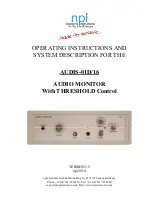
66251750-EN - V1.0 - 05/06/17
56
4000 Series Vandal Resistant Digital GSM Audio Intercom with Proximity
4000 Series Vandal Resistant Digital GSM - Technical Manual
The digital GSM intercom will reply with the following text:
CLK = 17/04/24, 10.05
OK VIDEX GSM
SILENT DIALLING MODE (AUE)
When the digital GSM is calling the telephone number stored there is a choice of either hearing the ringing noise from the intercom
panel or just hearing beeps to indicate a call is in progress.
• Ringing heard during calling: nnn = 001
• Beeps heard during calling: nnn = 000
The following text messages can be sent to the digital GSM intercom to enable (000), disable (001) or query the setting of the silent
dialling feature.
1111AUEnnn
Set the silent dialling mode nnn (where nnn = 001 or 000).
1111AUEnnn?
Set the silent dialling mode nnn (where nnn = 001 or 000) and send a confirmation text
back to the sender.
1111AUE?
Query the current mode stored. A text message will be sent back to the sender confirming
which silent dialling mode has been set.
ENABLE THE DIAL ‘0’ ON ANSWER FUNCTION (EDZ)
When enabled this feature allows an incoming call to an apartment to be diverted to the programmed divert telephone number
if the ‘0’ button on the telephone has not been pressed after answering the call. This can be useful if the user’s number has an
answerphone service (or answer machine) and they do not want the call to be answered by this service or if the primary number
(mobile no.) is switched off.
The default for this function is disabled (set to 000). The following texts can be used to enable or disable this function.
1111EDZnnn
Set the dial ‘0’ function nnn: 001 or 000 (001 = enable, 000 = disabled).
1111EDZnnn?
Set the dial ‘0’ function nnn: 001 or 000 (001 = enable, 000 = disabled) also send a
confirmation text back to the sender.
1111EDZ?
Query the dial ‘0’ mode set.
When this feature is set (enabled = 001) the user answering the call must press ‘0’ on their phone to accept the call otherwise the
call will be diverted to the next number.
ENABLE THE ‘#’ (HASH) FUNCTION (ED#)
Once enabled the user must press the
#
button on their phone before pressing any other button (also refer to user command table
1 on page 63) with the exception of when the user needs to enter the 4 digit master code “
1111
”.
The user will have up to 3 seconds to press the user command button required (e.g. button
3
to activate the panel’s relay), if the user
doesn’t press the next button within the 3 second window they will have to press the
#
button again.
The default for this function is disabled (set to 000). The following texts can be used to enable or disable this function.
1111ED#nnn
Set the # function nnn: 001 or 000 (001 = enable, 000 = disabled).
1111ED#nnn?
Set the # function nnn: 001 or 000 (001 = enable, 000 = disabled) also send a confirmation
text back to the sender.
1111ED#?
Query the dial ‘#’ mode set.
ENABLE PROXIMITY READER (EPR)
The digital GSM features a built-in proximity fob/card reader. The proximity reader can be enabled or disabled depending on whether
this feature is required. By default the setting for this is disabled (proximity reader switched off ). The following programming text
mnessages are used to enable or disable the proximity reader (also see notes on page 41).
1111EPRnnn
Set proximity reader nnn: 001 or 000 (001 = enabled, 000 = disabled).
1111EPRnnn?
Set proximity reader nnn: 001 or 000 (001 = enabled, 000 = disabled) and send a
confirmation text back to the sender.
1111EPR?
Query proximity mode set. A text message will be sent back to the sender confirming if
the proximity reader is enabled or disabled.
Programming via Text Message
















































